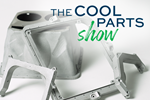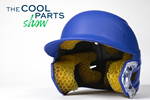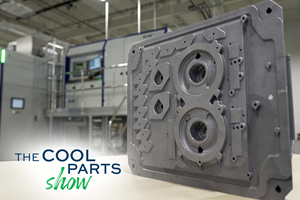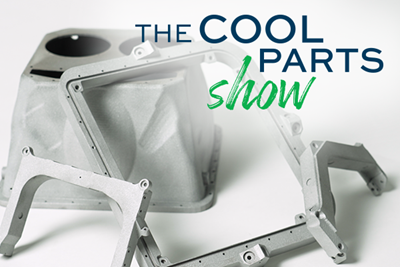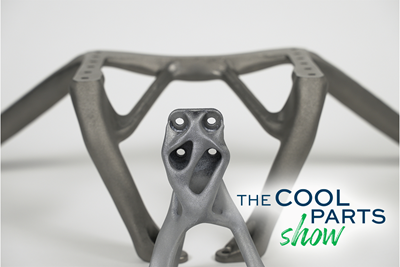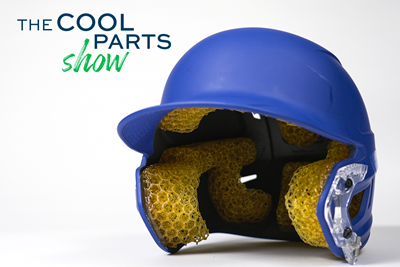Share
Read Next
NASA’s Mars Sample Return mission will send a spacecraft to the red planet to retrieve rock samples and carry them to earth — but the spacecraft will have to crash land once it gets back home. Carrying a parachute or other landing system would add too much weight and complexity. Therefore, the rock samples coming from Mars need to be cushioned against the violent arrival, and engineers at NASA’s Jet Propulsion Laboratory (JPL) have turned to additive manufacturing to create the strong, lightweight titanium lattice structures that will deliver this protection. In this bonus episode, The Cool Parts Show visits JPL to learn about not just the design and 3D printing of lattices optimized for this role, but also the postprocessing involved in making these lattice structures as light as possible for the sake of the interplanetary trip. Also in this episode: See the enhanced drop tower JPL uses to simulate the crash landing upon returning from Mars. | This episode of The Cool Parts Show is sponsored by Carpenter Additive
The Cool Parts Show is a video series from Additive Manufacturing Media that explores the what, how and why of unusual 3D printed parts. Watch more here.
Have a cool part to share? Email us.
Related Resources
- Mars Sample Return official NASA site
- NASA’s EXCITE mission using AI-designed 3D printed brackets
- 3D printed components on the Mars Perseverance Rover
- Very different application of 3D printed lattices: protecting cohosts’ heads
Transcript
00:00:08:23
Pete Zelinski
I’m Pete.
00:00:10:01
Stephanie Hendrixson
I'm Stephanie. And this is The Cool Parts Show our show all about interesting, amazing spacefaring 3D printed parts.
00:00:16:07
Pete Zelinski
This is a bonus episode. We did an episode not long ago involving NASA's Goddard Space Flight Center. We'll put a link in the show description. That episode was about a 3D printed component that was holding a sensitive instrument in place and protecting it on a craft that had to fall from the top of the earth atmosphere. Well, more recently, we visited another NASA facility and we learned about 3D printed hardware that is protecting a payload falling from a lot farther.
00:00:48:22
Stephanie Hendrixson
That's right. We recently had a chance to visit NASA's Jet Propulsion Laboratory, JPL, in Pasadena, California. We talked to an engineer there about some really interesting additive manufacturing work that is happening in service of the Mars Sample Return Mission.
00:01:02:14
Pete Zelinski
Mars Sample Return Mission. Here's what that's all about. The Perseverance Rover is on Mars right now. It's there with 3D printed parts, in fact. And we did an episode about that, too. That is also in the show description. But just one of the things that the Perseverance Rover is doing is gathering rock samples from Mars that can be examined to explore the question of whether there has ever been life on Mars in the past. The Mars Sample Return Mission is all about getting those rocks and bringing them back to Earth. So, a craft will launch from Earth, will go to Mars. A lander will gather up those samples, and then the spacecraft will return to Earth. And importantly, it needs to crash land, probably in the Utah desert. So a protective system has to be engineered that will ensure that these precious rock samples returning from Mars not only survive the crash, but that the containment is held in place completely, so that there's no interaction at all with the Earth's atmosphere.
00:02:15:13
Stephanie Hendrixson
And we should say this is an intentional crash landing. NASA has prepared for this. They could have incorporated a parachute or some other type of landing gear, but they needed to prepare for the worst case scenario, which would have been a crash landing.
And so they decided to just forego all of that complexity and prepare a vessel that would be able to survive that impact while also protecting these samples and keeping them isolated. So there were a number of different components that will play into this. But one of the key elements of this spacecraft is going to be 3D printed metal lattice structures.
00:02:46:13
Pete Zelinski
Lattice structures strong enough to protect the payload during this violent landing, light enough to not unduly burden this craft on this long journey that it has to take.
Enter additive manufacturing. This is The Cool Parts Show so you already know that 3D printing is the way that they're solving this problem. But 3D printing wasn't necessarily the choice. There were other options to consider. Here is Ryan Watkins, research engineer with NASA, JPL.
00:03:19:00
Ryan Watkins
This is actually an incredibly complicated mission architecture. This is a large scale lander, the largest thing we'll have ever landed on Mars that is going to land and through a combination of the Perseverance Rover and two fetch helicopters, we will actually collect all of the samples on the surface of Mars. We'll bring them back to this sample return lander, and then once properly packaged, we will launch them up into the orbit of Mars on what is known as the Mars Ascent Vehicle. And then the last element of this is a smaller spacecraft is jettisoned from this Mars Sample Return Orbiter and it crash lands. It plummets down onto the surface of the Earth. I wish I could say that additive manufacturing was the clear choice from the beginning, but we actually have a lot of engineering solutions to solve problems like this. There's really kind of two main elements to protecting something from breaking. And the first is you have a large amount of energy that is coming in and striking something and you need to disperse the duration in which that impact occurs. And the more you can spread that out, the more you can reduce the load on what you're trying to protect. And the second aspect is you need some way to dissipate the energy. And so in say something like the cushions in a helmet that's through viscal elasticity in a plastic, whereas in a car it's through the crushing, the plasticity, the fracture as your car crumbles in the front. And so in the aerospace industry, we typically use things like aluminum foams or aluminum honeycombs to achieve those same desirable features.
00:04:59:08
Stephanie Hendrixson
Metal foam was sort of the initial idea for how to protect these samples. But what ultimately led them to metal 3D printing was a desire to be able to control the foam, the structure of the foam more precisely, but also the need for materials that could withstand the temperatures that this spacecraft is going to see on reentry.
00:05:18:03
Ryan Watkins
Making things like honeycombs and aluminum foams need very specialized manufacturing techniques that limit both the materials you can use and the forms that you can generate them in.
And so although we can take aluminum foams and we can machine them to fit into the very complicated geometries that we need for our sample return, we started identifying that the temperature, the thermal environment that these foams were going to go through was going to be potentially problematic. The temperatures could get so hot that we might actually get to the melting point of aluminum.
And on top of that, we needed maybe lower thermal conductance.
And so aluminum was maybe no longer the right choice for us. But from a manufacturing standpoint, all of the metal foam manufacturing processes are centered around aluminum. And there are a couple of places maybe you can make something like titanium, but they aren't really made for structural purposes right now. And so it was really aluminum. And if we couldn't overcome those thermal issues, we didn't really have another option. So for the current design, and I will note that we are in the middle of design and things are always changing. But as things stand right now, we're looking at making titanium lattices because they're not only kind of heat resistant to the levels that we expect, but their strength to weight ratio is about two times higher than aluminum.
00:06:39:22
Pete Zelinski
We've done episodes before on 3D printed lattices, and the way the 3D printed geometry can get just the right springy-ness for whatever it's trying to protect. This is a little different. You heard Ryan mention crushable lattices, so these are lattices engineered to deform in just the right way to channel away the energy of the impact.
00:07:04:12
Ryan Watkins
So the reason that we use crushable structures for energy absorption is really for two reasons. The first is we're trying to protect something. And so if we know our sample tube breaks under 100 pounds of load, we can actually design a crushable that fails at 80 pounds of load. And so in conjunction with its failure at 80 pounds of load and its ability to continue to crush at this constant load, we can sacrifice this energy absorber to make sure that we don't break our samples. And so that was really the first challenge in designing these lattices. And so what we're really focusing on was through simulation, we were able to roughly predict over a wide range of lattices what they would crush at. Based on different geometric properties, like how dense the structure was or what their different squished aspect ratios were.
00:07:56:06
Stephanie Hendrixson
So what Ryan's describing is really important. There wasn't really a software tool on the market that could do exactly what NASA needed it to do. So to generate the geometries for these crushable lattices and to simulate their performance and figure out what the right one even was, he had to develop his own software program to do this.
00:08:13:13
Ryan Watkins
The typical ways you might do a hand calculation or do a finite element analysis are these very point designs that take a lot of effort to create. And so to an explore a large design space it's a very cumbersome, slow trial and error process. And so I decided to kind of step back and come up with an architecture where we could make arbitrary lattice geometries and simulate their performance in a robust and automated fashion. And from there that then allowed us to then make a huge database of lattice properties and with that database linked all together with a graphical user interface, an engineer can now sit down and go, “Well, I care about the stiffness of the lattice. I care about how this lattice is going to crush,” and they can look at all of that information in the context of more than 15,000 different point designs that we've looked at. And then they can go through and filter down based on their specific engineering requirements, what lattice they need to choose for their very specific application. And so this whole design suite that I've created is called Unit Cell Hub, and it consists of three specific components. The first is Unitcell Engine. It's the whole back end that's able to model the geometry, mesh it and simulate it. And then with this very robust modeling framework, it then feeds into the second module, which is called Unitcell DB. This is a huge database of different point designs where I did a parametric study of varying unit cell types and relative densities and aspect ratios. That's now over 15,000 different designs that have been investigated to date. And when you wrap these two modules together into a Unitcell App, which is this front end graphical user interface, you're now able to rapidly investigate all of this complicated design spaces and really focus down into what unitcell is right for your specific application.
00:10:13:20 - 00:10:29:02
Pete Zelinski
There were multiple challenges. The digital computational modeling and simulation challenge was huge. So much so Ryan and his team had to develop their own software tool for designing lattices. The Unitcell Hub, the Unitcell Engine, the Unitcell App. That's one of the challenges. But then there was physically 3D printing this form. The challenge there was the length, scale separation that this involved. These lattices needed to be very fine in the detail of their strut sizes, but also 3D printed across a relatively large volume and a given 3D printing platform could be expected to do very well in one or the other. Either 3D print very fine features or 3D print large objects. JPL needed both. 3D printing was the answer. But in order to get these fine lattices over a large size, they needed something else after 3D printing.
00:11:18:21
Ryan Watkins
In the manufacturing, a 3D printer is generally tuned to make a certain geometry range. And so maybe for classic laser powder bed fusion, you know, that's often it can print well down to one millimeter up to maybe a couple hundred millimeters. And lattices really push the bounds of both of those things. And so what we started to run into is as we wanted to print these really fine lattices that like the one millimeter scale, we were losing quality in our prints. We were getting subsurface defects, we were getting poor surface finish, all of which negatively affect the performance of our lattices. And so we had to identify pretty early on was that taking our print right out of the printer wasn't going to be sufficient. We were going to have to do some kind of post process so we could get a usable geometry for our needs. And that's what led us into this post process step of chemical etching.
00:12:13:19
Stephanie Hendrixson
So what JPL discovered is that they can 3D print these lattices, make them a little bit oversize, and then use this chemical etching process to reduce the density, to remove the material that they need to get out of there while also improving the surfaces at the same time.
00:12:26:13
Pete Zelinski
The lattice forms as 3D printed are too big, too thick in the lattice struts. Chemical etching allows them to be dissolved down to just the right fineness, just the right size. So this is the process that JPL is going forward with and refining and fine tuning.
00:12:46:16
Ryan Watkins
We begin with our nominal print, which we actually build with stilts off of our build plate. This allows us to very accurately not only cut the final geometry, but it also helps prevent any thermal distortions that are pretty common in titanium prints. From there we then go do a hot isostatic press to kind of help improve the material properties of the titanium structure. From there, we cut it off the build plate and we go to our final post process step, which is that etching. From there we give it to our etching vendor and we go, “We want to etch this one to 2% relative density. We want to etch this one to 3% relative density.”
00:13:25:20
Stephanie Hendrixson
So metal 3D printing brings all of this geometric complexity, lets you engineer exactly the lattice you want, but if you're after a crushable lattice metal printing alone might not be enough. And so chemical etching is now this additional knob, this additional option that NASA can tune to get exactly the density in this structure that they want.
00:13:44:04
Pete Zelinski
JPL is there or they're nearly there. They've got the design. These crushable lattice structures. They've got the manufacturing process, laser powder bed fusion, plus chemical etching. Next up, how do you test these lattice forms? I mean, really test them. For something that is intended to survive, endure a crash landing on a return trip from Mars. How do you test that?
00:14:09:08
Stephanie Hendrixson
Two words, drop tower. We got to see this at JPL, the tower where they're actually testing these different lattices, testing different parts of this system that is going to Mars and coming back. But actually Drop Tower doesn't even say it all that well, because in order to replicate the forces that this spacecraft is going to see, they actually have to sort of slingshot it into the ground to really simulate this.
00:14:32:01
Ryan Watkins
We are still in the preliminary design stage on Mars Sample Return and so although we have a strong understanding of what the baseline design should look like, design is an ever changing process.We have a dedicated large scale drop tower here at JPL that was custom built to do this type of testing. And so we use this testing to not only characterize how these lattices are going to crush, but ultimately down the line, we will also use these drop tests to qualify our whole system that it's going to survive when it does this big round trip journey and ultimately comes back and crash lands on Earth.
00:15:09:15
Pete Zelinski
So that big long round trip Earth to Mars and back. It's got to wait for Earth and Mars to be in the right positions relative to one another. So the launch from Earth to Mars 2027, the launch of the lander down onto the surface of Mars 2028, and then that return trip with that crash landing, 2033.
00:15:34:02
Stephanie Hendrixson
So mark your calendars for those launches and landings. But if you want more cool parts in the meantime, we have several other episodes that deal with parts that are either going to space or there already. So, for instance, we have an episode about brackets that are being used in NASA's EXCITE Balloon Mission, which we'll be launching soon.
We have an episode about parts on the Perseverance Rover, which is already out there on Mars, and there are probably a few more coming soon, so make sure to subscribe on YouTube or sign up for that All Access Newsletter to get notified about our new content.
00:16:05:06 - 00:16:06:23
Pete Zelinski
Thanks for watching.
Related Content
Top 10 Additive Manufacturing Stories of 2023
Laser powder bed fusion, proprietary AM processes, machining and more made our list of top 10 articles and videos by pageviews this year.
Read More3D Printed Brake Panel for the Rail Industry: The Cool Parts Show #52
In this episode of The Cool Parts Show, laser powder bed fusion simplifies the manufacturing of air brake panels for light rail systems made by Wabtec.
Read More8 Cool Parts From Formnext 2023: The Cool Parts Show #65
New additive manufacturing technologies on display at Formnext were in many cases producing notable end-use components. Here are some of the coolest parts we found at this year’s show.
Read MoreAdditive Manufacturing Is Subtractive, Too: How CNC Machining Integrates With AM (Includes Video)
For Keselowski Advanced Manufacturing, succeeding with laser powder bed fusion as a production process means developing a machine shop that is responsive to, and moves at the pacing of, metal 3D printing.
Read MoreRead Next
3D Printed Parts on the Mars Perseverance Rover: The Cool Parts Show #23
The Perseverance parts made through additive manufacturing are extreme examples of lightweighting. We have replicas of the 3D printed parts that were sent to Mars.
Read More3D Printed "Evolved Structures" for NASA Exoplanet Balloon Mission: The Cool Parts Show #61
Generative design creates stiff, lightweight brackets for EXCITE mission monitoring planets orbiting other stars. The Cool Parts Show visits Goddard Space Flight Center.
Read More3D Printed Lattices Replace Foam for Customized Helmet Padding: The Cool Parts Show #62
“Digital materials” resulting from engineered flexible polymer structures made through additive manufacturing are tunable to the application and can be tailored to the head of the wearer.
Read More


